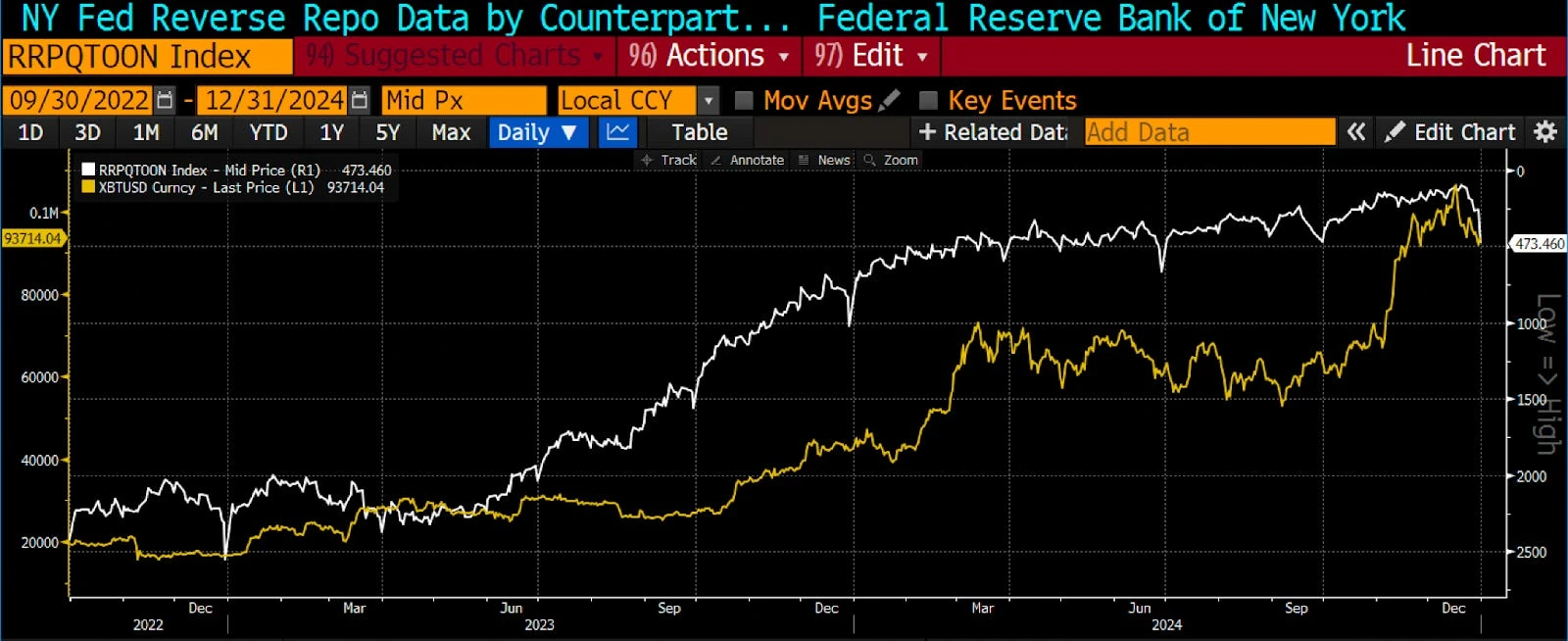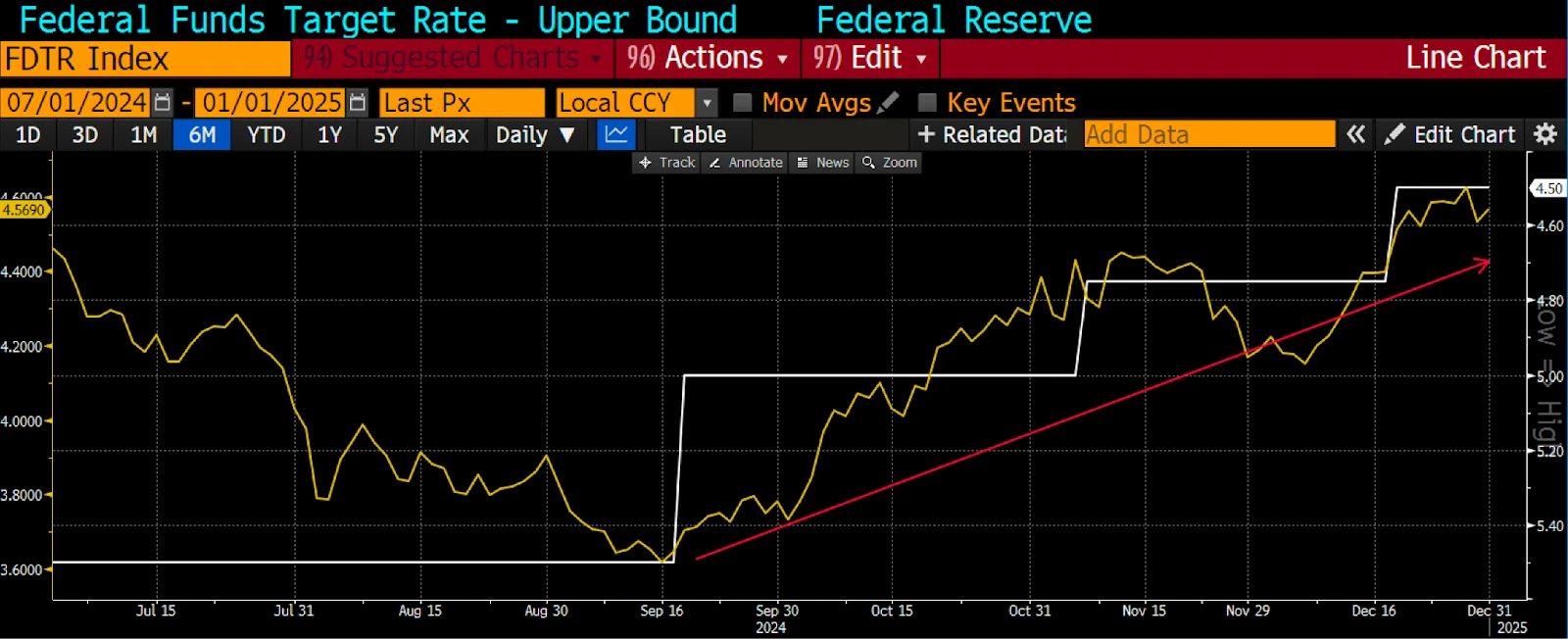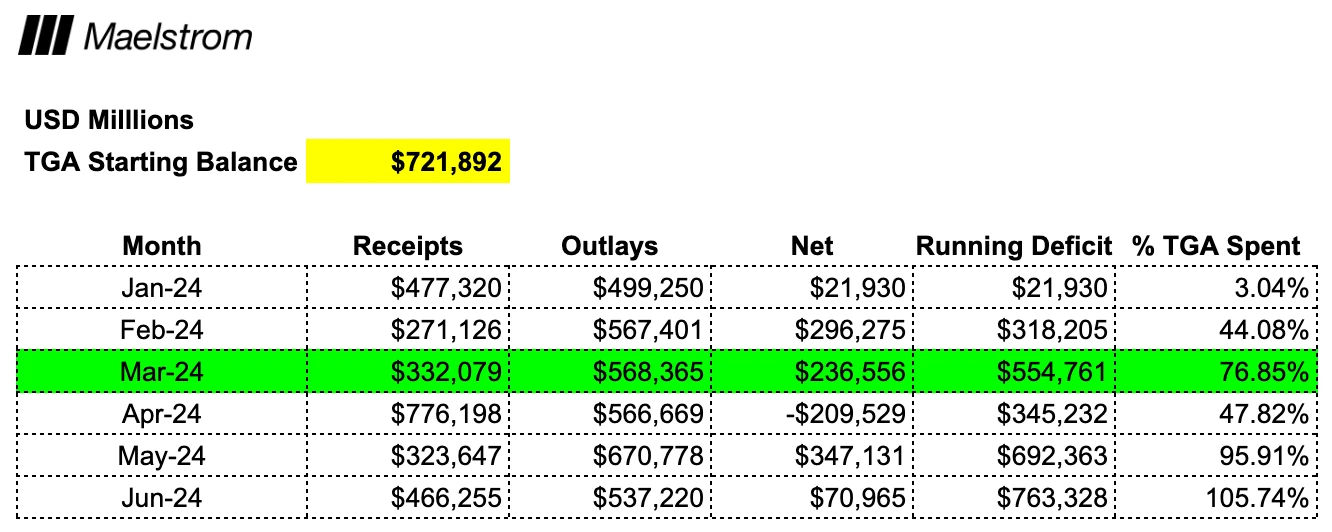原作者 | 亚瑟·海斯 (BitMEX 联合创始人)
已编译 经过 奥黛丽 行星 日常的 ( @OdailyChine )
譯者| 东 ( @azuma_eth )
Editors note: This article is a new article Sasa published by BitMEX co-founder Arthur Hayes this morning. In the article, Arthur analyzes the possible subsequent actions of the Federal Reserve and the Treasury Department, and the impact of related actions on the overall dollar liquidity situation in the market. Arthur is generally optimistic about the first quarter market, and believes that the markets disappointment with the effect of the Trump teams policy shift can be masked by the extremely positive dollar liquidity environment, but at the same time Arthur also predicts that the market will peak at the end of the first quarter and will not improve until the second half of the year. Arthur also mentioned that his fund Maelstrom has bought multiple DeSci concept coins such as BIO, VITA, ATH, GROW, PSY, CRYO and NEURON, and believes that the market will soon re-price DeSci.
The following is the original text of Arthur, translated by Odaily. Because Arthurs writing style is too free and easy, there will be a lot of free play in the text that is irrelevant to the main content. In order to facilitate readers understanding, Odaily will make some deletions to the original text when compiling.

A type of bamboo called Sasa grows near ski resorts in Hokkaido. The stems of this bamboo are thin, like reeds, but they have sharp green leaves that can cut the skin if you are not careful. Therefore, skiing can be very dangerous if there is not enough snow to cover the ski slopes.
Hokkaidos snowfall this year set a 70-year record, so the gates to the ski resorts opened in late December instead of until the first or second week of January as in previous years.
-
Odaily Note: These two paragraphs are not all nonsense. You will know what Arthur wants to express after reading to the end.
In my last article, Trump Truth , I predicted that the market had too high expectations for the policy changes after Trump took office, which would breed disappointment. I still think this is a potential negative factor that may drag down the market in the short term, but at the same time, I have to balance the driving role of US dollar liquidity. For now, Bitcoin rises and falls with the changing rhythm of the US dollar supply. The people in power at the Federal Reserve and the US Treasury determine the supply of US dollars in the worlds financial markets.

Bitcoin bottomed in the third quarter of 2022, when the Feds reverse repurchase facility (RRP) peaked. At the behest of U.S. Treasury Secretary Bad Gurl Yellen (Arthurs nickname for Yellen), the Treasury issued fewer long-term interest-bearing bonds and more short-term zero-coupon notes, which drained more than $2 trillion from the RRP. This was injecting liquidity into global financial markets. Cryptocurrencies and stocks (especially those large technology stocks listed in the United States) plummeted as a result. The above figure shows Bitcoin (left, yellow) compared to RRP (right, white, inverted) – it can be seen that as RRP fell, Bitcoin rose almost synchronously.
The question I want to answer is whether the positive supply of US dollar liquidity can offset the markets disappointment with the strength of Trumps policy shift, at least in the first quarter of 2025. If the answer is yes, then it is safe to trade now and Maelstrom should also increase the risk on the book.
I will discuss the Fed issue first, but it is only a minor factor in my analysis. After that, I will discuss how the U.S. Treasury will respond to the debt ceiling issue. If politicians hesitate to raise the debt ceiling, the Treasury will drain its general account (TGA) at the Fed, injecting liquidity into the system and creating positive momentum for 加密货币货币。
For space reasons, I will not explain why the borrower and lender sides of RRP and TGA have a negative and positive impact on USD liquidity respectively. If you haven’t read my previous article, please refer to Teach Me Daddy for the detailed mechanism.
Fed
The pace of the Fed’s quantitative tightening (QT) policy remains at $60 billion per month, which means that the size of its balance sheet has shrunk. There is no change in the Fed’s forward guidance on the pace of quantitative tightening. I will explain why later in this article, but my forecast is that the market will peak in mid-to-late March, so QT will result in $180 billion of liquidity being removed from January to March.
The RRP has fallen to almost zero. In order to completely exhaust the mechanism, the Fed belatedly changed the policy rate on reserve requirements. At its December 18, 2024 meeting, the Fed cut the RRP rate by 0.3%, 0.05% more than the policy rate cut. This was to tie the RRP rate to the lower bound of the federal funds rate (FFR).
If you are curious why the Fed waited until the RRP was almost exhausted to align the interest rate with the lower bound of the FFR and reduce the attractiveness of depositing in the mechanism, I strongly recommend reading Zoltan Pozars article Cheating on Cinderella . The takeaway from his article is that the Fed is doing everything it can to stimulate demand for US Treasury issuance before it stops QE, grants US commercial bank branches a supplementary leverage ratio exemption again, and may resume quantitative easing (QE), also known as starting the printing press.
Currently, there are two pools of money that will help keep bond yields in check. For the Fed, it is imperative that the 10-year Treasury yield not exceed 5% as this is the level at which bond market volatility explodes (MOVE index). As long as there is liquidity in the RRP and TGA, the Fed does not have to make drastic changes to monetary policy and acknowledge that fiscal dominance is working. Fiscal dominance actually confirms Powell’s subordination to Yellen and her successor Scott Bessent (Trump’s nominee for the new Treasury Secretary). I will give that Scott guy a nickname sooner or later, but I haven’t come up with a good one yet. If this affects his decision-making and makes me look like a modern Scrooge McDuck by choosing a devaluation of the dollar (compared to gold), I will give him a more flattering nickname.

Once the TGA is exhausted (USD liquidity is positive) and then replenished by the debt ceiling being hit and raised (USD liquidity is negative), the Fed will have no stopgap measure to prevent yields from moving inexorably higher since the decision to start the easing cycle last September. However, this is not really important for USD liquidity conditions in the first quarter, but just a passing thought for how Fed policy may evolve later this year if yields continue to rise.

A comparison of the FFR cap (right, white, inverted) with the US 10-year yield (left, yellow) clearly shows that bond yields have risen as the Fed has cut rates when inflation has run above its 2% target.
The real question is how quickly the RRP falls from about $237 billion to zero. I expect it to approach zero sometime in the first quarter as money market funds (MMFs) maximize their yields by withdrawing funds and buying higher-yielding Treasury bills (T-bills). In other words, this means $237 billion of USD liquidity injections in the first quarter.

After the December 18 RRP rate adjustment, Treasury bills with maturities of less than twelve months are yielding above 4.25% (white), the lower bound for the federal funds rate.
The Fed will remove $180 billion of liquidity due to quantitative easing, while the Fed will encourage an additional $237 billion of liquidity injection due to the reduction in RRP balances caused by its adjustment of the reward rate. In total, the net liquidity injection is $57 billion.
Ministry of Finance
Yellen told the market that she expects the Treasury to take extraordinary measures to fund the U.S. government between January 14 and 23. The Treasury has two options for paying the governments bills. They can either issue debt (negative USD liquidity) or spend money from the Feds checking account (positive USD liquidity). Since the total debt will not increase until the U.S. Congress raises the debt ceiling, the Treasury can only spend money from its checking account (TGA). Currently, the TGA balance is $722 billion.
The first big if is when the politicians agree to raise the debt ceiling. This will be the first test of whether Trump’s support among Republican lawmakers is rock solid. It’s important to note that Trump’s governing margin—that is, the number of Republicans over Democrats in the House and Senate—is very thin. There is a faction of the Republican Party that likes to puff its chest and smugly, claiming every time the debt ceiling is debated that they care about reducing the size of bloated government. They will insist on voting for raising the ceiling until they get some benefits for their constituencies. Trump has been unable to convince them to veto the 2024 year-end spending bill without raising the debt ceiling; Democrats have already been beaten in the last election and are in no mood to help Trump free up government funds to achieve his policy goals. Harris 2028 comeback? Anyone want to see this plot? In fact, the next Democratic presidential nominee will be Gavin Newsom. So to get his job done, Trump would be wise to exclude the debt ceiling from any legislative proposals until he has to.
Raising the debt ceiling would be necessary when failure to do so would result in a technical default on maturing Treasury bonds or a full government shutdown. Based on the Treasury Departments 2024 revenue and expenditure projections , I estimate that this will happen between May and June of this year, when the TGA balance will be completely depleted.

Understanding the speed and intensity of the TGA funding the government can help predict when reducing funding will have the greatest effect. 市场s are forward-looking, and given that these are public data and we know how the Treasury will operate if the accounts are nearly depleted and the total amount of US debt cannot be increased, the market will look for new sources of US dollar liquidity. With 76% of the funds depleted, March seems to be a time when the market will start asking what happens next.
If we add together the U.S. dollar liquidity of the Federal Reserve and the Treasury as of the end of the first quarter, the total comes to $612 billion.
What happens next?
Once a default and shutdown becomes imminent, a last-minute deal will be reached to raise the debt ceiling. At that point, the Treasury will be free to net borrow again and will have to refill the TGA. This is a negative for USD liquidity.
Another important date in the second quarter is April 15, when tax payments are due. As can be clearly seen in the table above, the governments fiscal position improved significantly in April, which was also negative for USD liquidity.
If factors affecting TGA balances were the only factors determining cryptocurrency prices, I would expect a local high to occur at the end of Q1. In 2024, Bitcoin reached a local high of around $73,000 in mid-March before moving sideways and beginning a multi-month decline ahead of the April 15 tax deadline.
交易策略
The problem with this analysis is that it assumes that USD liquidity is the most critical marginal driver of total global fiat liquidity. Here are some other contributing factors:
-
Will China speed up or slow down the creation of RMB credit?
-
Will the Bank of Japan start raising its policy rate, thereby allowing the dollar to appreciate against the yen and unwinding leveraged carry trades?
-
Will Trump and Scott cause the dollar to depreciate significantly relative to gold or other major fiat currencies overnight?
-
How effective is the Trump team at quickly reducing government spending and turning bills into law?
These big macroeconomic issues can’t be known in advance, but I have confidence in the math of how RRP and TGA balances will change over time. My confidence is further supported by how the market has performed from September 2022 to today: the increase in USD liquidity due to the decline in RRP balances has directly led to a rally in cryptocurrencies and stocks, even as the Fed and other central banks are raising rates at the fastest pace since 1980.

FFR cap (right, green) vs Bitcoin (right, magenta) vs SP 500 (right, yellow) vs RRP (left, white, inverted). Bitcoin and stocks bottomed out in September 2022, and the decline in RRP injected more than $2 trillion in liquidity into global markets. This was a deliberate policy choice made by Yellen to issue more Treasury bonds to consume deposit reserves. The effects of Powell and his actions to tighten financial conditions to fight inflation were completely offset.
With all the caveats in mind, I believe I have answered the question I asked at the beginning. That is, the markets disappointment with the effects of the Trump teams policy shift can be masked by the extremely positive US dollar liquidity environment, which can increase by up to $612 billion in the first quarter. Just like in previous years, at the end of the first quarter, we will sell as expected, relax on the beach, by the sea, or at a ski resort in the southern hemisphere, and wait for the positive fiat liquidity environment to reappear in the third quarter.
As Maelstroms CIO, I would encourage risk takers in this fund to adjust their risk to DEGEN (extreme). The first step in this regard was our decision to enter the booming DeSci space. We like undervalued shitcoins and have bought BIO, VITA, ATH, GROW, PSY, CRYO, and NEURON. Read Degen DeSci for why Maelstrom believes the DeSci narrative is poised for a higher re-valuation. If things play out as I describe, I will reduce my position sometime in March and start to get high.
Of course, anything can happen, but I am generally bullish. Does this mean that my views in the last article have changed? Somewhat. Perhaps the sell-off due to disappointment with the effects of Trumps policy shift has occurred in late 2024 instead of mid-January 2025. Does this mean that I am sometimes a bad forecaster? Yes, but at least I will absorb new information and views and adjust in time before major losses or missed opportunities occur.
This is why the investing game is so appealing. Imagine if you could get a hole-in-one every time you play golf, hit a three-pointer from midcourt every time you play basketball, and clear the table with one shot every time you play pool. What would life be like? QTMD, failures and successes are both necessary so that you can reap the joy of success, but I hope that overall successes can be more than failures.
This article is sourced from the internet: Arthur Hayes updates forecast: Market will peak in late March
Driven by the global information wave, the traditional business model of the telecommunications industry is facing unprecedented challenges. On the one hand, the initial investment pressure brought by 5G continues to increase. On the other hand, due to the delay in the transformation of its revenue model, value-added services have not seen any improvement so far. Traditional user communication service fee income continues to decline under the pressure of peer competition. As shown in the following figure, among the leading companies listed in the United States, although the revenue of the telecommunications service industry is 50% higher than that of Internet giants, its profitability is only 30% of the latter. The profit margin of the telecommunications industry is only 20% of that of Internet giants, and the net income is…







